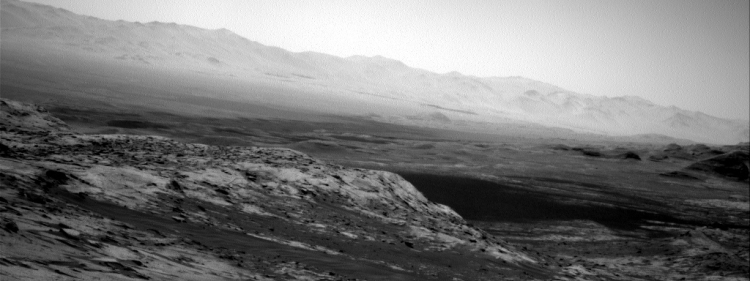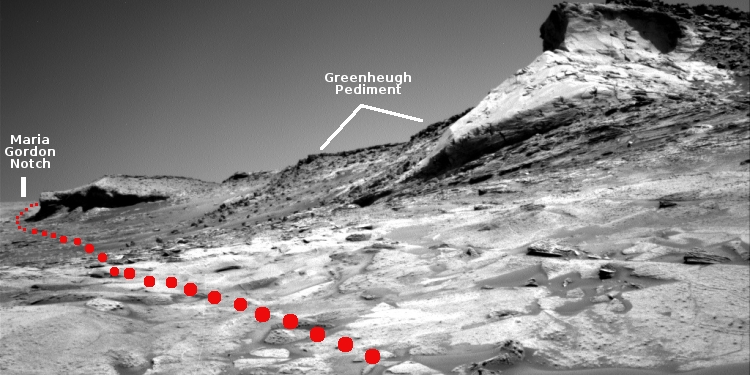Curiosity’s new mountain views
With the resumption of communications with Mars, following the two week hiatus because the Sun was in the way, Curiosity is about to begin its travels again. The view above, taken by the right navigation camera and reduced and annotated to post here, looks forward, with the red dotted line indicating the planned route.
The distinct white outcrop on the right top is the same spectacular outcrop I have highlighted previously.
At the moment however the rover is not going anywhere. Just before the hiatus the scientists had Curiosity move a short distance to crush some nearby nodules so that they could see their interior. At their update they post an image of one crushed nodule, and write the following:
[L]ook closely for very straight imprinted lines in the middle of flattened areas that appear slightly more grey. You can also see cracks, especially clearly on the right of the nodule in the image, but if you look around, you’ll find there are more of them. Some of the scratched areas are looking white, too. All those features will allow us an insight into the nodules and an interpretation beyond what we can otherwise see on the surface.
The image below, also taken by the right navigation camera and reduced to post here, looks back at Curiosity’s earlier travels, across the floor of Gale Crater about 1,500 feet below. The rim, about 25 miles away, can be seen through the atmospheric haze as the distant mountain chain.
See the orbital map at this post in September to get the context of what the two images are viewing. The top image looks south along the cliff line, the bottom looks almost due north.

Click for full image.
On Christmas Eve 1968 three Americans became the first humans to visit another world. What they did to celebrate was unexpected and profound, and will be remembered throughout all human history. Genesis: the Story of Apollo 8, Robert Zimmerman's classic history of humanity's first journey to another world, tells that story, and it is now available as both an ebook and an audiobook, both with a foreword by Valerie Anders and a new introduction by Robert Zimmerman.
The print edition can be purchased at Amazon or from any other book seller. If you want an autographed copy the price is $60 for the hardback and $45 for the paperback, plus $8 shipping for each. Go here for purchasing details. The ebook is available everywhere for $5.99 (before discount) at amazon, or direct from my ebook publisher, ebookit. If you buy it from ebookit you don't support the big tech companies and the author gets a bigger cut much sooner.
The audiobook is also available at all these vendors, and is also free with a 30-day trial membership to Audible.
"Not simply about one mission, [Genesis] is also the history of America's quest for the moon... Zimmerman has done a masterful job of tying disparate events together into a solid account of one of America's greatest human triumphs."--San Antonio Express-News
With the resumption of communications with Mars, following the two week hiatus because the Sun was in the way, Curiosity is about to begin its travels again. The view above, taken by the right navigation camera and reduced and annotated to post here, looks forward, with the red dotted line indicating the planned route.
The distinct white outcrop on the right top is the same spectacular outcrop I have highlighted previously.
At the moment however the rover is not going anywhere. Just before the hiatus the scientists had Curiosity move a short distance to crush some nearby nodules so that they could see their interior. At their update they post an image of one crushed nodule, and write the following:
[L]ook closely for very straight imprinted lines in the middle of flattened areas that appear slightly more grey. You can also see cracks, especially clearly on the right of the nodule in the image, but if you look around, you’ll find there are more of them. Some of the scratched areas are looking white, too. All those features will allow us an insight into the nodules and an interpretation beyond what we can otherwise see on the surface.
The image below, also taken by the right navigation camera and reduced to post here, looks back at Curiosity’s earlier travels, across the floor of Gale Crater about 1,500 feet below. The rim, about 25 miles away, can be seen through the atmospheric haze as the distant mountain chain.
See the orbital map at this post in September to get the context of what the two images are viewing. The top image looks south along the cliff line, the bottom looks almost due north.

Click for full image.
On Christmas Eve 1968 three Americans became the first humans to visit another world. What they did to celebrate was unexpected and profound, and will be remembered throughout all human history. Genesis: the Story of Apollo 8, Robert Zimmerman's classic history of humanity's first journey to another world, tells that story, and it is now available as both an ebook and an audiobook, both with a foreword by Valerie Anders and a new introduction by Robert Zimmerman.
The print edition can be purchased at Amazon or from any other book seller. If you want an autographed copy the price is $60 for the hardback and $45 for the paperback, plus $8 shipping for each. Go here for purchasing details. The ebook is available everywhere for $5.99 (before discount) at amazon, or direct from my ebook publisher, ebookit. If you buy it from ebookit you don't support the big tech companies and the author gets a bigger cut much sooner.
The audiobook is also available at all these vendors, and is also free with a 30-day trial membership to Audible.
"Not simply about one mission, [Genesis] is also the history of America's quest for the moon... Zimmerman has done a masterful job of tying disparate events together into a solid account of one of America's greatest human triumphs."--San Antonio Express-News



Dr. Carol Stoker – Finding Life on Mars – 2021 Mars Society Virtual Convention
https://www.youtube.com/watch?v=-6yheH2LngA
“From the 24th Annual International Mars Society Convention, held as a Virtual Convention worldwide on the Internet from October 14-17, 2021.”